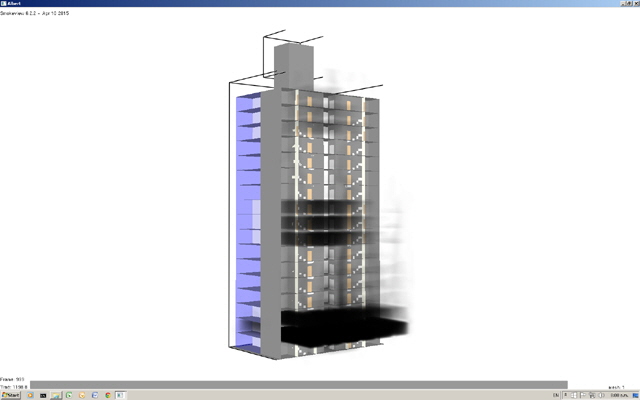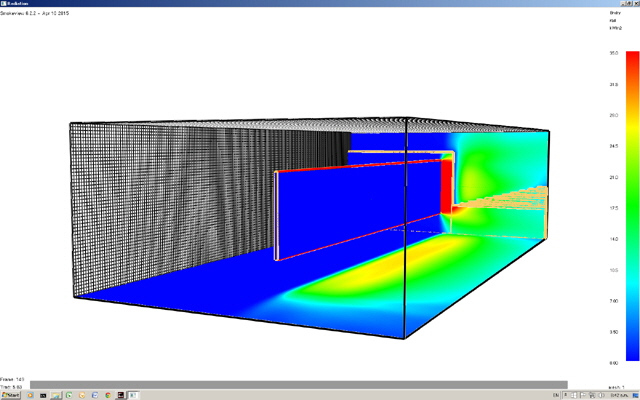Alternative and specific fire engineering designs may require Computational Fluid Dynamics (CFD) to model fire conditions over time. The CFD model of industry choice is Fire Dynamics Simulator1 (FDS) by NIST. The software is free, has been subject to significant validation, is widely used, and well supported.
Computer modelling of large buildings with complex geometries can result in an appreciable computational burden. Aside from the time required to build a representative model2, a simulation can take days or weeks to run over the period of interest. Further, most projects will require examination of a number of fire scenarios and sensitivity analysis. You might be interested in our recent study into High Performance Computing for FDS.

High Rise Pressurization for Smoke Control
Producing meaningful CFD output in a reasonable time-frame requires that the underlying model should be optimized for both the problem under consideration and for computational efficiency.
A computer model is just that – a model. While it is possible to produce a model that will look exactly like your finished building this is neither necessary or desirable for the purposes of fire modelling.
Provided that the model is sufficiently representative of your building for the issues under consideration then there can be significant cost and time savings in using a simplified representation of the actual structure with no detriment to the validity of the fire analysis. FireNZE has the expertise to optimize your model.
In a recent project FireNZE reduced an FDS model developed by others from a computational domain of over 32 million cells to just 2.6 million cells (still a moderate computational burden). The model was further optimized for efficient parallel processing. This resulted in a 93% improvement in processing speed without any loss of resolution in the areas of interest for the project.
While FDS (and its companion program SmokeView) can produce images that depict flame and smoke spread, these will not necessarily be representative of a real fire in your building. Fire is a stochastic process and even under laboratory conditions no two fires are identical. Occasionally extreme events do occur. The power of CFD is not in the images but the underlying physics and the processed numerical output.

Study of Radiation to the Boundary
But model optimization may not always be enough to get results within project time-lines without significant computer resources. FireNZE has dedicated CFD computing resources to achieve truly high speed parallel processing. Our Linux cluster incorporates 26 high speed Intel cores running at up to 5.8 GHz3, with over 100 GB of RAM and Solid State Hard Disks (SSHD), all coupled through a dedicated 40 Gb/s Infiniband network. The software environment has been optimized using Intel compilers and kernel libraries. Our cluster has been bench-marked as world class. And we have additional networked high speed computational resources for concurrent model development, testing and data processing.
If our in-house resources won’t meet your needs then we can sub-contract super computer resources with 1,000’s of cores through NESI, although for most modelling our own cluster will be faster and lower cost.
Our cluster is maintained with the latest release of FDS verified against the NIST test suite. You can see a typical verification report at FDS Verification Report.
Our model results are available immediately for analysis with no need for extensive (and potentially insecure) data transfer from cloud-based third party resources. Your data is secure with FireNZE. We maintain a proven grand-father, father, son backup of all electronic files remotely stored in a fire-proof safe.

Modelling Wind and Fire Spread
If you have a fire engineering problem that requires advanced computer modelling then FireNZE has the resources and expertise to provide you with model development, processing and analysis in industry-leading time-frames.
1. There are other computational models for the analysis of fire that may be more appropriate for some projects. FireNZE is proficient in many of these packages including the zone models BRANZFire and CONTAM.
2. FireNZE retains a commercial license and has specific training on PyroSim for efficient model development.
3. We prefer to run our processors at 4.4 GHz Turbo for long term stability but we will over-clock for even faster performance subject to contracted cost provisions.

(c) Aquacoustics Limited
Updated 24 Nov 25